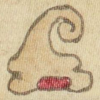Colhuacan (Azca9)
This compound glyph stands for the place name, Colhuacan (also spelled Culhuacan). It is a frontal view of a golden hill or mountain (tepetl) with a curved peak (colli) leaning toward the viewer's left. Multiple rocky outcroppings (groups of three small lobes each) appear on the slopes. At the base of the hill are red and yellow horizontal stripes, the usual site for spring water to emerge. The hill has a dark cave with a red and golden-spotted bird inside, seemingly in flight with its head in profile, facing right, and its beak open. Behind the head of the bird is an unidentifiable object. Another light-colored animal (perhaps a rabbit) sits on the curved peak and faces toward the viewer's right with its red tongue protruding, and a tripartite flowering plant appears above the cave, its roots visible above ground. The flowers are quincunxes, with four petals and a round center. These added elements on the landscape seem to be represent the flora and fauna of the region in that period.
Stephanie Wood
post-1550, possibly from the early seventeenth century
Jeff Haskett-Wood
nombres de lugares

col(li), something bent or curved, https://nahuatl.wired-humanities.org/content/colli-1
hua-, possession, https://nahuatl.wired-humanities.org/content/hua
-can (locative suffix), https://nahuatl.wired-humanities.org/content/can-2
Culhuacan
Stephanie Wood
The Codex Azcatitlan is also known as the Histoire mexicaine, [Manuscrit] Mexicain 59–64. It is housed in the Bibliothèque Nationale de France, and hosted on line by the World Digital Library and the Library of Congress.
https://www.loc.gov/resource/gdcwdl.wdl_15280/?sp=9&st=image
The Library of Congress is “unaware of any copyright or other restrictions in the World Digital Library Collection.” But please cite Bibliothèque Nationale de France and this Visual Lexicon of Aztec Hieroglyphs.







